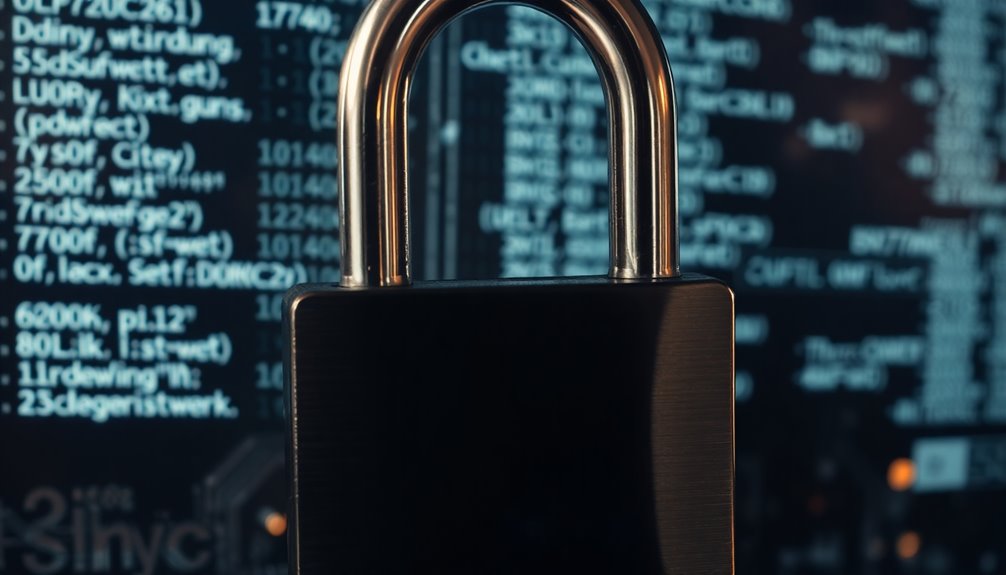zkSync is a Layer 2 scaling solution for Ethereum that boosts transaction speeds and lowers costs. Using zero-knowledge proofs, it can process over 20,000 transactions per second, vastly outperforming Ethereum's 15. This means less congestion and significantly reduced gas fees for you. By batching transactions, zkSync optimizes efficiency and ensures smooth confirmations. While it presents pros like enhanced scalability and lower fees, potential drawbacks include slower withdrawal speeds. Overall, zkSync represents a promising advancement in blockchain technology. If you're curious about its features and future upgrades, there's more to uncover.
Key Takeaways
- zkSync is a Layer 2 scaling solution for Ethereum that enhances transaction speed and reduces gas fees using zero-knowledge proofs.
- It can process over 20,000 transactions per second, significantly surpassing Ethereum's capacity of 15 transactions per second.
- Transactions are batched off-chain, improving efficiency and minimizing congestion on the Ethereum mainnet.
- zkSync offers EVM compatibility, allowing seamless asset transfers and reducing costs for developers.
- Future upgrades, such as EIP-4844, aim to further lower transaction costs and improve overall user experience.
Layer 2 Scaling Solution

While Ethereum has revolutionized decentralized applications, its scalability issues have prompted the development of Layer 2 scaling solutions like zkSync.
This solution uses zero-knowledge proofs, specifically zk-SNARKs, to bundle multiple transactions off-chain into a single cryptographic proof. It then verifies these proofs on the Ethereum mainnet, ensuring both security and finality.
By separating ownership from computation, zkSync handles assets on the main chain while managing computation and storage off-chain. This architecture allows zkSync to process thousands of transactions per second compared to Ethereum's 15, far exceeding Ethereum's 15 transactions per second. As a result, it reduces congestion and high gas fees, making it a vital component of the Ethereum ecosystem for faster and more affordable transactions.
Overview of Zksync's Purpose

zkSync serves to bridge the gap between Ethereum's powerful capabilities and its inherent scalability limitations. It significantly enhances transaction throughput, allowing you to handle thousands to over 20,000 transactions per second.
By introducing Hyperchains, zkSync enables independent ZK chains with customizable consensus mechanisms, ensuring robust security and finality. This platform not only optimizes transaction costs by compressing multiple transactions into single proofs but also utilizes zero-knowledge proofs to enhance your privacy. Additionally, zkSync's use of zkRollup technology allows for high scalability while maintaining Ethereum's security.
You'll find it perfect for decentralized finance (DeFi) applications, reducing confirmation times and fees. With its developer-friendly approach, zkSync supports Solidity and offers comprehensive tools, making it easier for you to create efficient, Ethereum-compatible applications.
Transaction Batching Efficiency

By effectively batching transactions, zkSync drastically improves efficiency and reduces costs for users. It combines multiple transactions into a single proof, minimizing computational and storage demands on the Ethereum mainnet. The transactions are sliced into L2 blocks, which are then merged into L1 batches, allowing you to spread the submission gas cost across all transactions. This batching mechanism enables zkSync to handle thousands of transactions per second (scalability), significantly enhancing scalability.
Plus, you'll notice swift validation the moment your transaction gets included in an L2 block, ensuring a smoother experience. With reduced gas fees and subsecond confirmation times, zkSync transforms your interactions with decentralized applications, making them quicker and more affordable.
Pros and Cons Analysis

When exploring zkSync, it's essential to weigh the benefits against the drawbacks to understand its impact on your blockchain experience.
On the plus side, zkSync offers enhanced scalability, allowing thousands of transactions per second at significantly lower gas fees. You'll enjoy improved user experience with fast confirmations and advanced security using zero-knowledge proofs that protect your privacy. This is crucial since zkSync aims to achieve VISA-scale throughput of transactions, making it a practical solution for everyday users.
However, there are some cons to consider. Withdrawal speeds can be slow, and computational demands might limit dApp development. Plus, while zkPorter offers cost-efficient storage, it may compromise security. Lastly, the complexity of zkSync could hinder widespread adoption, necessitating ongoing improvements to support a broader range of use cases.
Balancing these factors is crucial for informed decision-making.
Zksync vs. Ethereum Mainnet

Comparing zkSync to the Ethereum mainnet highlights significant differences in performance and user experience.
zkSync can process over 20,000 transactions per second, far surpassing Ethereum's capabilities, which means quicker transactions for you. Plus, zkSync offers lower gas fees, allowing you to save more on each transaction, making it more user-friendly. With its EVM compatibility, you can easily transfer assets between the two networks without changing wallets or tokens. Developers also benefit from reduced costs and robust tools for building applications. Overall, zkSync provides a seamless, efficient alternative to the Ethereum mainnet, focusing on scalability and cost-effectiveness while maintaining security and decentralization. Additionally, zkSync processes over 150 times more transactions than the Ethereum mainnet, significantly enhancing the overall efficiency of the network. You'll likely find zkSync a more appealing option for your blockchain needs.
Security Vulnerabilities in Protocol

Although zkSync offers impressive scalability and lower fees, it's not without its security vulnerabilities. Recently, ChainLight discovered a serious bug in the zk-circuits that could potentially lead to a loss of $1.9 billion if exploited. A malicious actor could manipulate transactions, making them appear valid to Layer-1 smart contracts. This critical bug was located in the zkSync Era's zk-circuits for transaction validation.
Fortunately, exploiting this issue requires high-level access, such as the protocol's backend or validator private key. Matter Labs acted swiftly to implement a fix after the report.
However, the use of centralized consensus mechanisms like pBFT and DPoS raises concerns about security. While zkSync employs multiple defense layers, vulnerabilities still exist, underscoring the need for continuous vigilance in the evolving blockchain landscape.
Emerging Zk-Rollup Applications

With security vulnerabilities in protocols like zkSync being a pressing concern, the focus now shifts to the innovative applications emerging from zk-rollup technology.
You'll find projects like Memento Blockchain unifying TradFi and DeFi, offering seamless digital fund management using ZKsync Elastic Chain.
The Sophon Entertainment Project is reshaping the entertainment landscape, competing with platforms like Spotify while raising significant funds, and it benefits from higher throughput provided by zk-rollup technology.
Nodle Network introduces biometric authentication and engages over a million token holders, enhancing real-world use cases on Ethereum.
Meanwhile, QuarkID is set to serve 750 million users, transforming identity management.
In the Creator Economy, projects like ZK Candy and Lens Protocol integration leverage zk-rollups for enhanced user experiences and scalability, pushing the boundaries of what's possible in this space.
Optimize Gas Fees Effectively

Gas fees can be a significant hurdle in the zkSync ecosystem, but understanding how to optimize them can lead to substantial savings.
First, pay attention to the gas fee structure: off-chain fees are constant, while on-chain fees fluctuate based on Ethereum's gas price. You can lower your maximum gas amount to save money, but be cautious—setting it too low might cause transaction failures. Unused gas fees are refunded automatically post-transaction, which can significantly lower your effective cost.
Experimenting with different gas limits helps you find the sweet spot. Additionally, consider using paymaster contracts, which can allow you to cover fees with ERC-20 tokens, enhancing your payment flexibility.
Keep an eye on future upgrades like EIP-4844 and zkPorter, as they promise to further reduce transaction costs and improve efficiency.
Frequently Asked Questions
How Does Zksync Improve Transaction Speed Compared to Ethereum Mainnet?
zkSync improves transaction speed by processing transactions off the Ethereum mainnet.
You'll notice that multiple transactions get aggregated into a single batch, which is then verified using zero-knowledge proofs.
This method enables zkSync to handle over 2000 transactions per second, compared to the Ethereum mainnet's 14-15 TPS.
As a result, you experience almost instant confirmations, especially during high network demand, significantly enhancing your overall experience.
What Cryptocurrencies Are Supported by Zksync?
You'll find that zkSync supports a variety of cryptocurrencies and tokens.
These include native assets like Ethereum (ETH) and Wrapped Bitcoin (WBTC), as well as ecosystem-specific tokens such as DMAIL and VNO.
If you're interested in DeFi or NFTs, you can trade tokens like ZF and WEFI.
Additionally, zkSync offers cross-chain options, including WMATIC and TIUSD, making it versatile for your trading and investment needs.
Can Developers Easily Integrate Zksync Into Their Applications?
Imagine effortlessly weaving a seamless experience into your application, where users glide through transactions without a hitch.
You'll find integrating ZKsync into your projects a breeze. Its developer SDK simplifies authentication, while compatibility with existing SDKs means you won't need to overhaul your codebase.
With features like passkey authentication and easy session management, you can create a user experience that feels familiar yet innovative.
It's all about making your development journey smooth and efficient.
Is Zksync Decentralized or Controlled by a Single Entity?
You'll find that zkSync is currently decentralized at level 4 on the scale, meaning it operates non-custodially without relying on any single entity.
You can withdraw funds without validator cooperation, ensuring a level of trustlessness.
The governance involves multiple bodies: the Token Assembly, Security Council, and Guardians, all working together to manage the protocol.
This structure prevents any one group from having complete control, promoting a collective decision-making process.
How Do Users Interact With Zksync Wallets?
You interact with ZKsync wallets by initializing them with a private key through Web3.js. You can choose compatible wallets like ZKsync Lite or MetaMask.
Once set up, you can manage your ETH and ERC-20 tokens, query balances, and conduct transactions seamlessly. You can deposit and withdraw funds between Layer 1 and Layer 2, all while enjoying low fees and fast confirmations for your transactions.
Conclusion
In a world where blockchain transactions could take eons, ZkSync swoops in like a superhero, slashing wait times and gas fees to smithereens! You're not just saving money; you're saving precious moments of your life. With its mind-blowing efficiency and security, ZkSync transforms the crypto landscape faster than a speeding bullet. So, why stick to the sluggish Ethereum mainnet when you can zoom through transactions and unleash the true power of your digital assets? Embrace the revolution!









